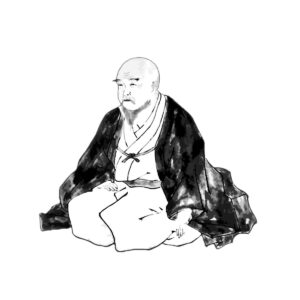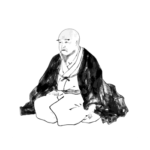
Tea master and political merchant in Sakai, Izuminokuni (Osaka Prefecture).
Born in 1520.
Son-in-law of Shao’o.
Together with Muneyoshi and Rikyu, he was known as one of the three masters of the tea ceremony under heaven.
His first name was Kyuhide, and later Kaneto.
He called himself Hikohachiro and Hiko-emon, and took the name Gyomusai.
He was a descendant of the Sasaki clan of the Omi Genji clan.
He was based in Imai-sho, Yamato Province (Kashihara City, Nara Prefecture), but later moved to Sakai and became a member of the barn-shu, casting guns and managing the Ikuno Ginzan Silver Mine.
He was already close to Ashikaga Yoshiaki and also maintained a relationship with Matsunaga Hisahide, but when Nobunaga entered Kyoto in 1568, he immediately visited Sakai and presented a famous Matsushima tea urn to him. In 1582, he was appointed to the post of chief of the Sakai district.
After 1582, he became close to the Hideyoshi administration and received a grant of 2,200 goku of rice field land.
After Shao’o’s death, he became the guardian of his heir, Sogawara, and had a lawsuit with Sogawara over his inheritance.
He had in his possession a painting of a tamagatami wave, a Jutoku chashaku, a hand lantern vase, a Teika shikishi, a Shao’ou eggplant tea caddy, a Seiko tea caddy, a Kaizan Gotoku, a Shimekiri mizushi, and Shao’ou hibashi (chopsticks).
He died on August 5, 1593, at the age of seventy-four.
The tea ceremony notes of soukyu Imai.
Two volumes.
Originally ten volumes, but was reissued in 1820.
(The first volume was published in 1554 (Tenkan), and the second volume was published in 1823 (Bunsei 3).
The first volume contains records of 20 tea ceremonies held by the tea master himself and 63 by others from 1554 to 1589, while the second volume contains records from 1599 to 1614.
The second volume contains records of the tea ceremony from 1599 (Keicho 4) to 1614 (same period 9), including the tea ceremony at the mountain village seat in Osaka Castle in 1584 (Tensho 12), the decorations of Hideyoshi Kitano in Kyoto on March 8, Tensho 13, the tea ceremony transmission letter of Furuta Oribe to Daishoma dated August 12, and the tea ceremony transmission letter of Soyoshi Kenshosai to Lifenin on September 13, Tensho 13.
The lower volume is said to have been recorded by soukyu’s son Mune Kaoru.
Included in “The Complete Collection of Tea Ceremony Classics,” Vol. 10.
Mune Kaoru Imai and Soton] Mune Kaoru was the son of soukyu.
He was the son of soukyu.
He was a tea master of Hideyoshi.
After the Sekigahara War, he served Tokugawa Ieyasu, Hidetada, and Iemitsu.
He died on April 10, 1627 at the age of 76.
Soton was the son of Sokaoru.
He was named “Fujin” and “Kaya Kosai” and learned tea ceremony from his father.
He died on April 13, 1623.








